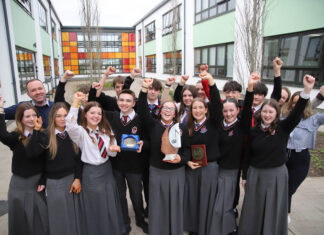COMMENCEMENT of the Opera Site development later this year took a step closer today with the publication of tenders for preliminary works on the site.
After achieving full planning permission in February, Limerick Twenty Thirty DAC (LTT) has sought submissions for the demolition and enabling works on the 3.7acre site, which will be the largest inner-city commercial development undertaken outside of Dublin.
The Opera Site, which was acquired by Limerick City Council in 2011 after a previous plan to develop it failed in the downturn, will be capable of employing up to 3,000 people across a 450,000 sq ft campus. The project will be developed to LEED Gold and Nearly Zero Energy Building (NZEB) standards and commence in Q3 of this year.
It is one of the largest projects in the LTT portfolio and will be developed over a six-year period at a total cost of circa €180 m.
It is fully funded thanks to commitments from the European Investment Bank and the Council of Europe Development Bank and planning permission for the project was granted by An Bord Pleanála in February of this year.
Welcoming the news, Mayor of the City and County of Limerick Cllr Michael Sheahan said that it’s a very positive signal for Limerick.
“We all know the transformational impact that the Opera Site is going to have on Limerick,” he said, continuing, “The timing couldn’t be better for this announcement as it comes in the midst of a really challenging period for us all and when we need to see such positive signs of recovery. This is a clear and definite signal of that.”
Said David Conway, Limerick Twenty Thirty CEO, said the demolition and enabling works will “be as big as anything undertaken in the city centre” as part of what is “a huge programme”.
“We are looking at a 3.7acre site in the heart of the city that is significant in scale and in sensitivity,” he said, adding, “There’s substantial demolition and clearing works to be done to prepare it for a LEED standard build, which is the world’s leading green-building project and performance management system. But it’s also much more than a demolition phase of the project, an enabling job. Also there’s a very substantial conservational aspect to this.
Mr Conway said the group will be “paying a lot of attention” to the conservational aspect to the development, saying, “among the requirements we have set are that the contractor will have a specific Conservation Architect and Archaeologist to oversee all works to the existing historic buildings on the site, as well as an Environmental Manager to oversee and monitor all the works with potential impact on the surrounding environment.”
“That’s the level of respect and detail we are applying to this job and it will be a standard we will bring through the entire project,” he said.
Denis Brosnan, Chairman of Limerick Twenty Thirty said when Limerick Twenty Thirty was established, the Opera Site was “the biggest project on the horizon” as well as the most spoken about.
He said, “It’s taken two years to get it to this stage but now the physical work begins and that’s a huge moment for the wider programme, for Limerick and the region.
“The public looked on at a half-built shell on Henry Street for years wondering if anything would ever be done to it and we got that turned around into a multi-award winning project within two years of the establishment of Limerick Twenty Thirty. The same will now happen with the Opera Site and it’s going to be a game-changer for Limerick.”
This first phase of the works will be done in consultation with the Limerick City and County Council Regional Waste Management Team to minimise waste generated on the project and the successful tenderer will have to commit to an Employment Charter that will ensure local communities benefit from any new employment opportunities that may arise from the project.
The demolition and enabling works scope includes installation of site hoarding and access gates to the full perimeter of the site; design and installation of traffic and pedestrian management systems; full site clearance to include the removal of all general waste, rubbish and debris from within buildings and lying in open areas around the site; design and installation of temporary and building stabilisation works and weatherproofing to buildings to be retained; careful demolition of buildings and structures and site grading and installation of a hardcore working platform for the next stage of the development.







